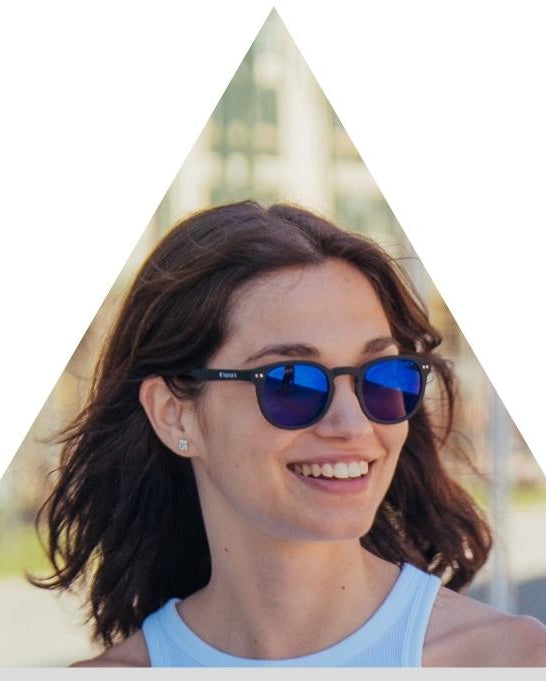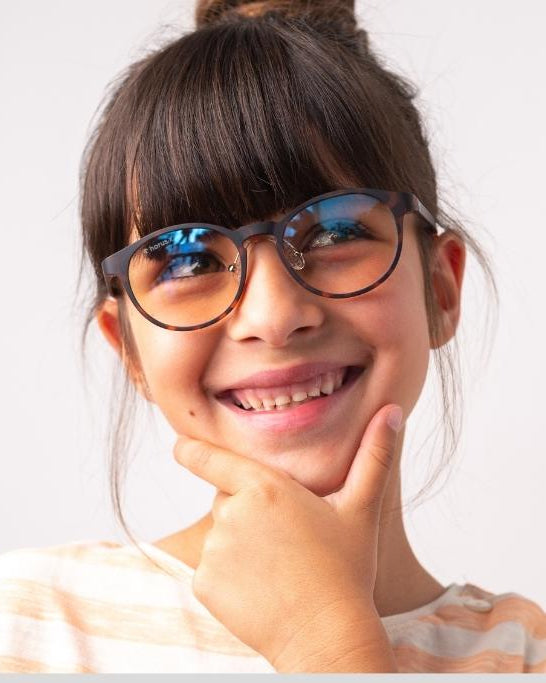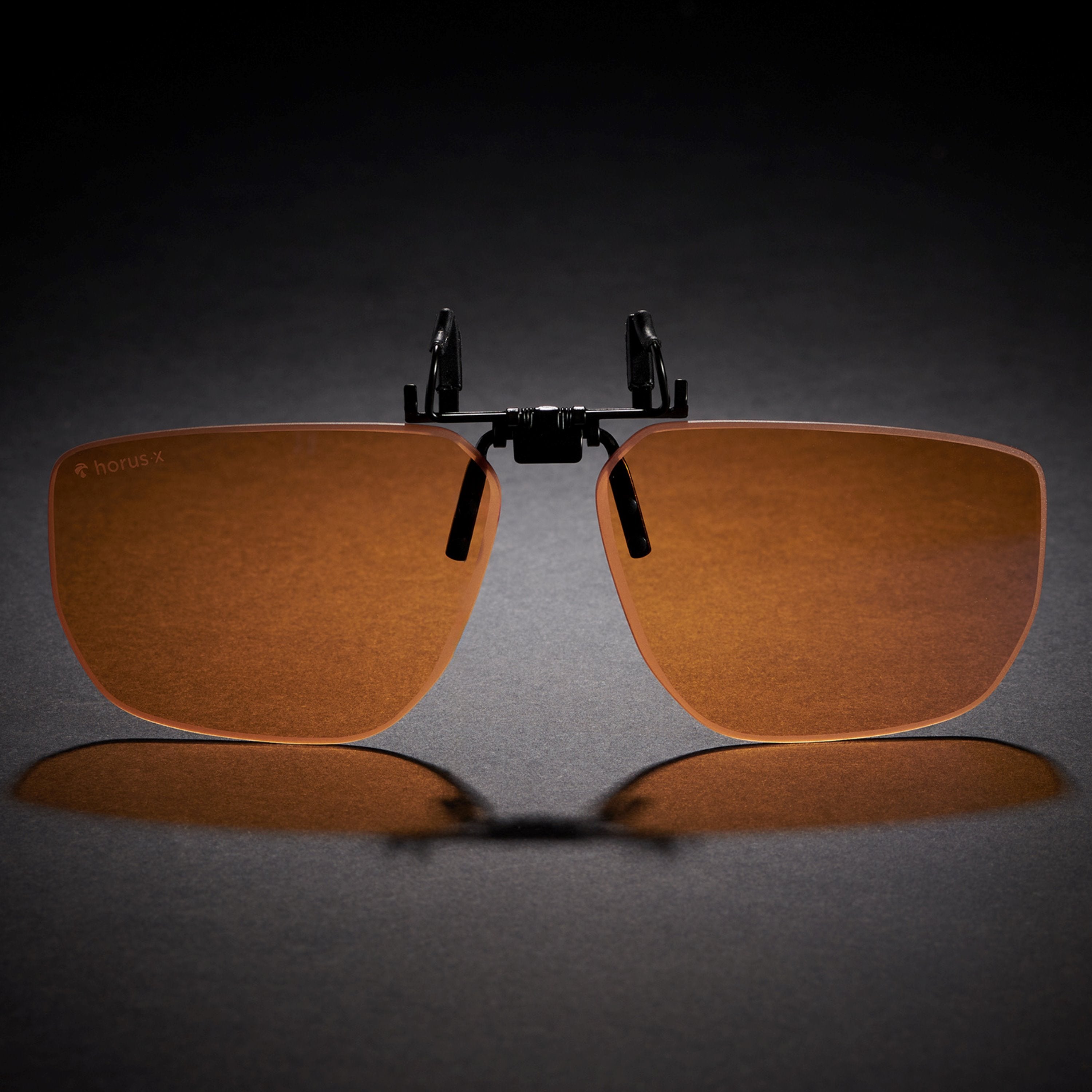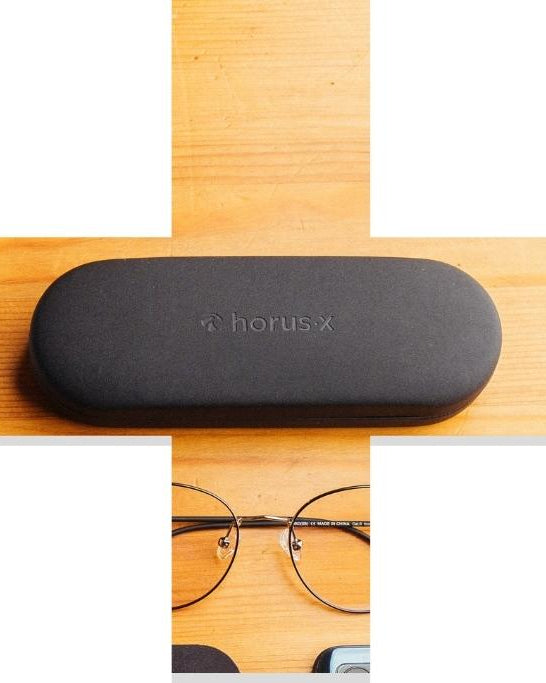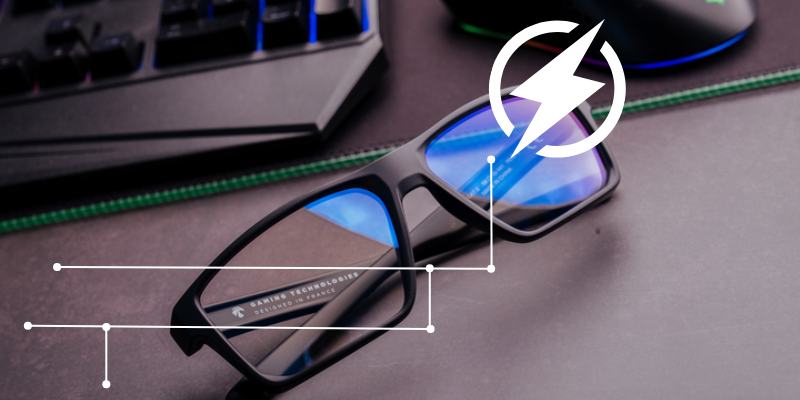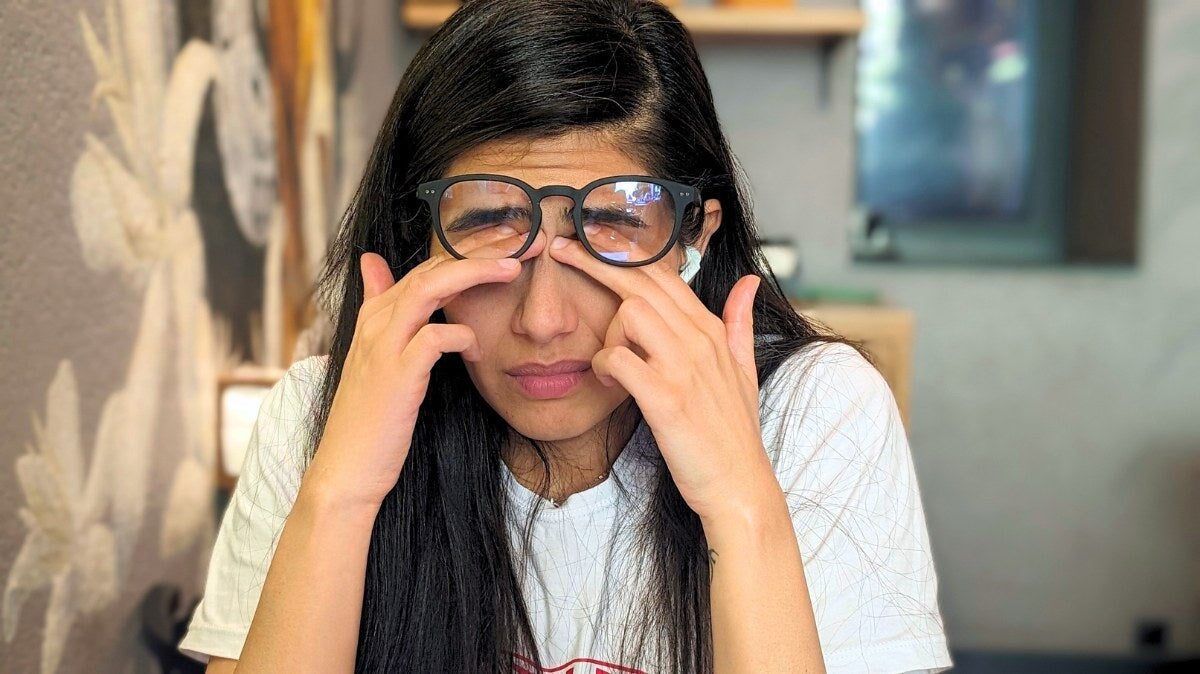People often confuse photophobia with heliophobia – the fear of light.
Photophobics don’t fear light, however, but are instead overwhelmed by it suffering from hypersensitivity. It’s not a condition but actually a symptom of a wider problem.
So, if you scramble back from light faster than Dracula in the mornings, you need to understand the possible causes of your photophobia.
In this article, we’ll look into the causes of photophobia, and the best ways to treat your ensitivity toward light. (Hint: glasses for photophobia exist!)
Photophobia: What exactly is it?

If someone shines a bright light in your eyes like you’re suddenly under interrogation about how long you played Fortnite for last night, then you’re going to flinch. No matter who you are, sudden bright light is unpleasant and it doesn’t mean you have photophobia.
Instead, photophobia is the difficulty in tolerating any light at all, both natural and artificial, and even those set at low intensities.
That means photophobic people will suffer when experiencing a variety of different light sources including:
- ☀️ Bright sunlight
- 📱 Screen brightness
- 🎆 Fluorescent light
- 💡 Incandescent light
- 🕯️ Candle flames
- 🚘 Automobile lights
What causes photophobia?
Anyone can experience photophobia, but it’s generally more common among people with light-colored eyes.
That’s because the multiple layers of their eye are less pigmented, and so don’t filter strong light as effectively as those with dark eyes.
People with albinism, for example, are also more likely to develop photophobia.
As we’ve mentioned, however, photophobia is a symptom not a cause, and there’s a number of things it can be indicative of.
Don’t panic. It could be a simple and benign as wearing the wrong contact lenses and suffering from irritation. But it could also point to a longer-term issue with your eye health, like the possibility of developing glaucoma or AMD (age-related macular degeneration). Either way, it’s better to get checked early so you can put any necessary interventions in place ASAP.
👀Eye diseases that cause photophobia

Eye conditions and diseases can sometimes cause photophobia. You might find you suffer from light hypersensitivity if you have one of the following:
- Keratitis: An inflammation of the eye and more especially of the cornea, the membrane located in front of the cornea and the iris.
- Inflammation of the iris: Namely the colored part of your eye
- Conjunctivitis
- Dry eye
- Glaucoma: Due to increased pressure inside the eye
- Uveitis: A inflammation of the uvea, located under the cornea
- Retinal pathologies
- Cataracts
- Blepharospasm: A spasm of the muscles around the eye causing involuntary blinking and closing of the eyes
- Irritation related to wearing contact lenses
🧠 Neurological causes
There are rare occasions where photophobia is a sign of something more debilitating, like a possible neurological disease. If you suspect your photophobia is cause by any of these, we advise you seek professional help immediately:
- Meningitis: An inflammation of the meninges which are the protective membranes of the brain and nervous system.
- Migraines which cause great sensitivity to sound and light
- Head trauma
- Brain tumors and hemorrhages
😢 Psychiatric causes
Mental health disorders can also cause physical symptoms like photophobia. For example, you might experience photophobia if you:
- Have depression and/or anxiety
- Take certain medications (anxiolytics, sedatives, etc.)
What are the symptoms of photophobia?
Photophobia is not considered a disease in itself but rather a symptom of a condition, such as those we’ve covered above.
The individual’s sensitivity to light can range from mild to Will Smith hearing a joke about his wife at the Oscars. For those of us like Will Smith, it can be a real daily handicap for sufferers.
Some of the most common signs that accompany photophobia are:
- 😶🌫️ Blurry vision
- 😴 Eye fatigue
- 🔥 Burning sensation in the eyes
- 🌵 Dry eyes
- 😵 Eye pain
- 😉 Excessive blinking
- 🫣Need to squint or close them completely
- 😭 Excessive tearing
- 🔴 Inflammation in the eyes (swelling , redness, irritation )
- 😵 Headaches, migraines and dizziness
- 🤮 Nausea and vomiting
- 😩 Neck stiffness
If you suffer from eye fatigue, or digital eye strain, increased light sensitivity can be a direct symptom. Luckily, it’s also usually temporary.
If you want to relieve the headaches of photophobia sooner, you can try using blue light blocking glasses for photophobia, which will help prevent fatigue caused by excessive screen use.
On the other hand, if the above corresponding symptoms and photophobia have come on suddenly and inexplicably, then we strongly advise you contact your doctor to find and treat the underlying cause.
How to diagnose photophobia
Strictly speaking, there is no diagnosis of photophobia.
In most cases, though, excessive sensitivity to light can be detected quite easily.
Once photophobia has been detected in a patient, the eye doctor (ophthalmologist) must look for the cause so that they can establish the appropriate treatment regime.
They should check medical history, symptoms and any current treatments, as well as carry out a full eye examination with tests and visual measurements. This will allow them to establish possible causes of the patient’s sudden photophobia.
Treatments for photophobia
Unfortunately, there’s no miracle treatment for photophobia. As with any symptom, it’s essential to find and treat the cause.
That’s why only a health professional can prescribe appropriate treatment, that’s relative to the patient’s situation.
For example:
If photophobia is caused by dry eyes, artificial tears to moisten the eyes will do the job.
If it’s linked to conjunctivitis, the doctor will prescribe a local treatment (such as eye drops) to clean your eyes and relieve the discomfort; or an ointment that can help clear infection.
If your photophobia is linked to a psychiatric or neurological disorder, your ophthalmologist will redirect you to the appropriate specialist for further treatment.
There are a number of treatments associated with photophobia and its corresponding cause. But there are certain precautions you can take if you already suffer from photophobia:
- 🕶️ Wear sunglasses when you're outside
- 🥏 Avoid wearing contact lenses or scrupulously respect hygiene rules
- 🔵 Use blue light blocking glasses to protect your eyes if you use screens (we have types for intensive and light use)
- 🔅 Adapt the ambient light indoors (for example, you can lower the shutters when the sunshine is too strong)
- ❄️ Avoid exposure to reflective surfaces (snow, water, etc.)
- 🥬 Opt for a natural treatment by choosing foods rich in zeaxanthin, a pigment good for the eyes that can reduce photophobia. You can find it in green vegetables (cabbage, spinach, lettuce), egg yolk or even goji berries, tomatoes or corn.
If your photophobia is temporary, resting your eyes or reducing the brightness of your surroundings generally helps relieve it quickly. Photophobia sunglasses can offer wonderful temporary relief but be cautious.
⚠️ Attention! Although it’s necessary for photophobic people to protect themselves from sunlight outdoors with suitable sunglasses, it is not recommended to wear them indoors.
Wearing sunglasses indoors can actually lower your light tolerance threshold and increase photosensitivity.
However, certain types of glasses can help alleviate the symptoms of photophobia a little, even indoors.
The best glasses for photophobia
If you struggle from permanent photophobia, there are a range of suitable glasses you can wear that will help relieve your suffering.
Glasses with tinted lenses

To reduce the intensity of light, you can opt to wear glasses that have tinted lenses.
These lenses are usually tinted pink, filter certain colors which can be harmful or strain our eyes. This helps reduce the development of migraines in people with photophobia.
They also protect against glare, by reducing the transmission of the light components responsible for this phenomenon (located around 484 nm on the light spectrum).
Tinted glasses also help reduce exposure to the blue-green wavelength of light (between 480 to 520 nm). This is particularly useful to those with photophobia as they often react more harshly to these wavelengths.
We recommend trying a tinted lens when you first experience symptoms of hypersensitivity to light, in order to reduce its effects.
Hypersensitivity to light occurs in approximately 90% of people affected by ophthalmic migraines. Studies have shown that the use of colored glasses relieve the intensity and frequency of symptoms in photophobic migraine sufferers.
These glasses are a strong option for those looking to treat their photophobia.
If pink isn’t your color and you don’t want to see the world through rose-colored lenses, there’s a variety of other color lens tints available including yellow, red and orange. Try a few and see which suit you best. You want to look good while relieving your symptoms after all.
But remember… not all tinted lenses are created equal. Choose your pair according to your needs and the intensity of your photophobia.
Polarized lens glasses

Since photophobic people struggle with all sources of light, it is obvious that being outside, in very bright conditions, is not ideal.
For this kind of situation, you can use photophobia sunglasses, which have polarized lenses.
These solar lenses significantly reduce reflections, and therefore glare, by offering additional protection against the light coming from reflective surfaces (water, snow, sand, road, etc.).
The good news is at Horus X, we don't just make anti-blue light glasses! You can find our models of sunglasses with polarized lenses here. Category 3 lenses, top protection against glare, stylish and with a lifetime guarantee. What more could you want?
Glasses with anti-reflective lenses

These glasses for photophobia have anti-reflective lenses.
This helps reduce the reflection of light in your eyes.
The coating applied to this type of frame reduces glare and reflections day and night, which is super helpful for those suffering from photophobia.
A lot of glasses have anti-reflective treatment, just be sure to check their specifications before buying.
Photochromic lens glasses

These glasses lenses darken upon exposure to (ultraviolet) UV rays.
That means you can use them indoors as regular eyewear and then outdoors as photophobia sunglasses. They’re a great option for those with a sensitivity to light.
Photophobia: Final thoughts
Photophobia is not a disease, but an increased sensitivity to natural and artificial light, which can cause serious discomfort or even an intolerance to light over time.
It can be caused by multiple factors.
That’s why it’s essential to understand the cause of photophobia to treat it effectively.
Once you’ve discovered the root cause, your doctor can implement an appropriate treatment regime to relieve it.
Glasses for photophobia help alleviate the symptom, and those with colored, anti-reflective or photochromic lenses can be really helpful for sufferers.



